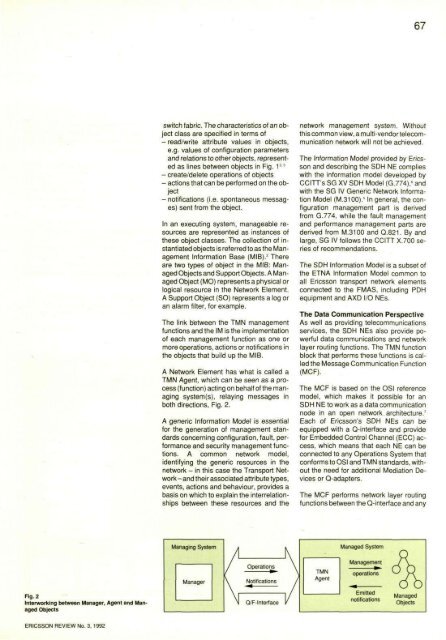An Introduction to the Ericsson Transport Network Architecture ...
An Introduction to the Ericsson Transport Network Architecture ...
An Introduction to the Ericsson Transport Network Architecture ...
You also want an ePaper? Increase the reach of your titles
YUMPU automatically turns print PDFs into web optimized ePapers that Google loves.
67<br />
switch fabric. The characteristics of an object<br />
class are specified in terms of<br />
- read/write attribute values in objects,<br />
e.g. values of configuration parameters<br />
and relations <strong>to</strong> o<strong>the</strong>r objects, represented<br />
as lines between objects in Fig. 1 2 3<br />
- create/delete operations of objects<br />
- actions that can be performed on <strong>the</strong> object<br />
- notifications (i.e. spontaneous messages)<br />
sent from <strong>the</strong> object.<br />
In an executing system, manageable resources<br />
are represented as instances of<br />
<strong>the</strong>se object classes. The collection of instantiated<br />
objects is referred <strong>to</strong> as <strong>the</strong> Management<br />
Information Base (MIB). 2 There<br />
are two types of object in <strong>the</strong> MIB: Managed<br />
Objects and Support Objects. A Managed<br />
Object (MO) represents a physical or<br />
logical resource in <strong>the</strong> <strong>Network</strong> Element.<br />
A Support Object (SO) represents a log or<br />
an alarm filter, for example.<br />
The link between <strong>the</strong> TMN management<br />
functions and <strong>the</strong> IM is <strong>the</strong> implementation<br />
of each management function as one or<br />
more operations, actions or notifications in<br />
<strong>the</strong> objects that build up <strong>the</strong> MIB.<br />
A <strong>Network</strong> Element has what is called a<br />
TMN Agent, which can be seen as a process<br />
(function) acting on behalf of <strong>the</strong> managing<br />
system(s), relaying messages in<br />
both directions, Fig. 2.<br />
A generic Information Model is essential<br />
for <strong>the</strong> generation of management standards<br />
concerning configuration, fault, performance<br />
and security management functions.<br />
A common network model,<br />
identifying <strong>the</strong> generic resources in <strong>the</strong><br />
network - in this case <strong>the</strong> <strong>Transport</strong> <strong>Network</strong>-<br />
and <strong>the</strong>ir associated attribute types,<br />
events, actions and behaviour, provides a<br />
basis on which <strong>to</strong> explain <strong>the</strong> interrelationships<br />
between <strong>the</strong>se resources and <strong>the</strong><br />
network management system. Without<br />
this common view, a multi-vendortelecommunication<br />
network will not be achieved.<br />
The Information Model provided by <strong>Ericsson</strong><br />
and describing <strong>the</strong> SDH NE complies<br />
with <strong>the</strong> information model developed by<br />
CCITT's SG XV SDH Model (G.774), 6 and<br />
with <strong>the</strong> SG IV Generic <strong>Network</strong> Information<br />
Model (M.3100). 5 In general, <strong>the</strong> configuration<br />
management part is derived<br />
from G.774, while <strong>the</strong> fault management<br />
and performance management parts are<br />
derived from M.3100 and Q.821. By and<br />
large, SG IV follows <strong>the</strong> CCITT X.700 series<br />
of recommendations.<br />
The SDH Information Model is a subset of<br />
<strong>the</strong> ETNA Information Model common <strong>to</strong><br />
all <strong>Ericsson</strong> transport network elements<br />
connected <strong>to</strong> <strong>the</strong> FMAS, including PDH<br />
equipment and AXD I/O NEs.<br />
The Data Communication Perspective<br />
As well as providing telecommunications<br />
services, <strong>the</strong> SDH NEs also provide powerful<br />
data communications and network<br />
layer routing functions. The TMN function<br />
block that performs <strong>the</strong>se functions is called<br />
<strong>the</strong> Message Communication Function<br />
(MCF).<br />
The MCF is based on <strong>the</strong> OSI reference<br />
model, which makes it possible for an<br />
SDH NE <strong>to</strong> work as a data communication<br />
node in an open network architecture. 7<br />
Each of <strong>Ericsson</strong>'s SDH NEs can be<br />
equipped with a Q-interface and provide<br />
for Embedded Control Channel (ECC) access,<br />
which means that each NE can be<br />
connected <strong>to</strong> any Operations System that<br />
conforms <strong>to</strong> OSI and TMN standards, without<br />
<strong>the</strong> need for additional Mediation Devices<br />
or Q-adapters.<br />
The MCF performs network layer routing<br />
functions between <strong>the</strong> Q-interface and any<br />
Fig. 2<br />
Interworking between Manager, Agent and Managed<br />
Objects<br />
ERICSSON REVIEW No. 3, 1992
















